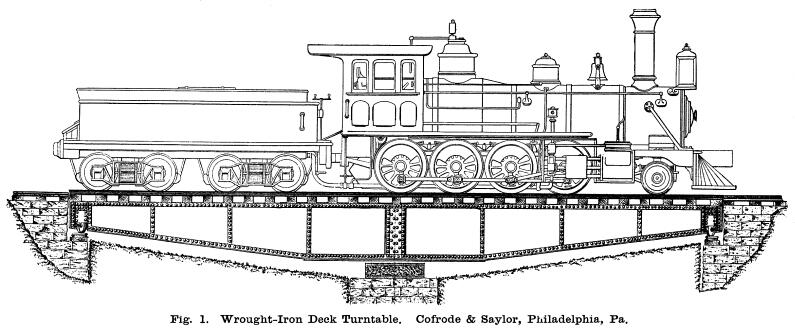Wrought-Iron Deck Turntable.
Engineering News—December 21, 1889
The accompanying cuts illustrate a type of wrought-iron deck
turntable for locomotives, as manufactured by Cofrode & Saylor,
of the Philadelphia Bridge Works, and patented in 188'7 and 1889
by Mr. F. H. SAYLOR, C. E., of the firm named.

In this turntable the main carrying girders are solid-web riveted
girders with angle-iron lateral and diagonal bracing. The cross-girders
are also made of plates and angles firmly riveted to the main
girders, as shown in Figs. 1 and 2. The construction of the center
pivot can best be understood by an inspection of the sections
shown in Fig. 2. The upper casting of this pivot has a square
projection on top planed so as to fit inside the box formed by
the cross-girders, to which latter it is firmly bolted. The middle
casting forms the top of the roller-box, and its top is planed
to a flat cylindrical surface, having its axis at right angles
to the table and accurately fitting the lower surface of the top
casting. A wrought-iron key is inserted between these plates to
prevent the two surfaces from sliding upon each other.

The special feature of the center pivot is found in this arrangement
of the two upper castings. The tendency of the table to tip laterally
is prevented by the horizontal cylindrical surface, which is about
20 ins. in width. The table can, however, tip slightly longitudinally,
so that when the locomotive runs upon it the trailing wheels bear
upon the circular track; but whenever the center of gravity is
within 16 ins. of the middle of the table, a full bearing surface
is furnished, and the tendency of the trailing wheels at both
ends is to rise clear of the circular track, and to remain so
while the table is being turned.
Steel plates, made to fit exactly the planed conical surfaces
of the lower and middle castings constituting the roller box,
provide bearings for the conical rollers.
Between these steel plates are chilled iron conical rollers,
ground to exact size, each 6¼ ins. in length almost completely
filling the roller box. In addition to these conical rollers there
are two hardened steel bearing plates, the lower being doweled
to the base casting and the upper provided with oil grooves to
insure free turning. The roller box is oiled through a wrought-iron
pipe extending through a plate iron cover on top of the cross
frame.
The lower half of the roller box constitutes the base plate,
and is 2 ft. 8 ins, square, with slightly rounded corners, and
is provided with four bolt holes 2 ft. 2 ins. apart, center to
center in each direction. These four holes are intended to receive
four wedge bolts 1-and-an-eighth in. in diameter, let into the
center bearing stone. The bolts should have 2-in. projection above
the stone to the under side of the nut. The center bearing stone
should not be less than 3 ft. square. All the parts of the center
pivot are made to exact gauge, so that they can be duplicated
at any time; they are the same size for all tables.
The vertical adjustment of the table is provided in a very
simple manner; there are no screw bolts for adjusting the height
at the center; this can be most readily accomplished by a wrought-iron
plate between the pivot and the masonry, should it at any time
be required. The adjustment at the ends of the table is provided
by simply changing the number of thicknesses of the packing plates
which are inserted between the journal boxes of the trailing wheels
and the channel iron cross-girders which carry these, whereby
the height of either of the trailing wheels above the circular
track can be fixed as desired. All tables are provided with four
packing plates, three-eighths-in. thick, for each journal box.
Two cast-iron sockets for wooden levers, and two latches are furnished
for each table.

This standard turntable is proportioned for turning an 86-ton
consolidation locomotive, or an equivalent load. and they are
turned out in lengths varying from 35 ft. to 75 ft. In a following
issue we will show a half-through wrought iron turntable as made
by the same firm.

A useful table of dimensions of pits, for turntables adapted
to lengths varying between 35 ft. and 60 ft., is issued by the
firm named, and is given herewith.
Structures
| Contents Page
|







